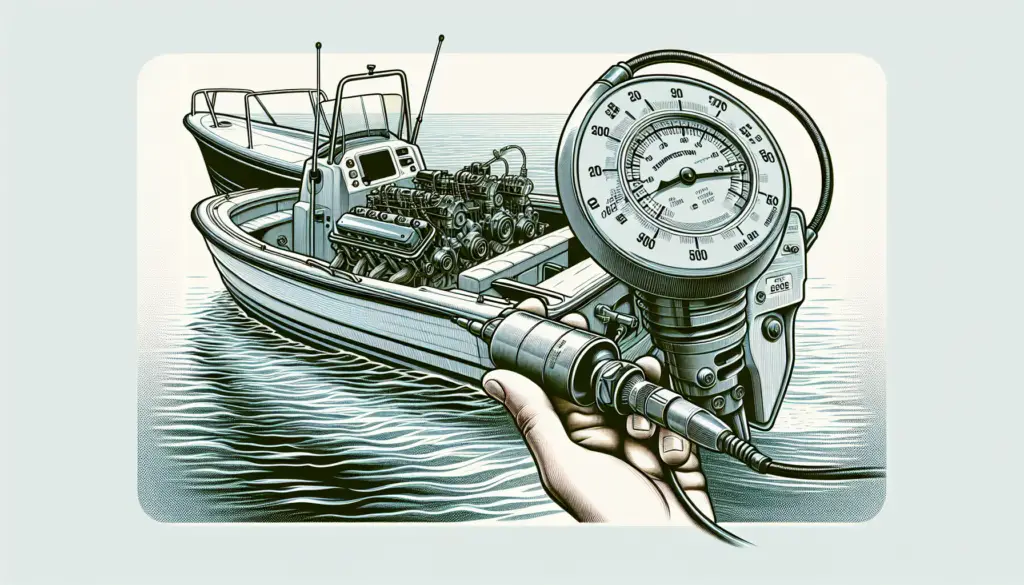Imagine you’re out on the water, enjoying a sunny day when suddenly, your boat engine starts sputtering. You’re not sure what’s going on but you suspect it might be a compression issue. Don’t worry, performing a compression test on your boat engine is not as daunting as it may seem. This guide will provide a comprehensive step-by-step process to effectively carry out a compression test on your boat engine. Keep reading to learn more about how to resolve your boat engine problems and prevent any future surprises on your sea voyages.

Understanding the Importance of a Compression Test
Understanding the state of your boat engine is crucial to smooth and enjoyable sea voyages. One of the ways to efficiently assess your boat engine’s health is through a compression test.
Why a compression test is necessary
A compression test gives you an insight into the functionality and condition of the internal parts of your boat engine. It’s a reliable way to check the health of your engine’s pistons, rings, and valves. If these parts aren’t working correctly, the performance of your boat will be compromised, and any issues might lead to costly repairs or replacement in the future.
Detecting engine issues through compression tests
Compression tests help you pinpoint problems with the combustion process in your boat’s engine. Through these tests, you can identify issues such as leakages from piston rings and valves, which could result in performance issues or even engine failure. This early detection can save you from the disaster of unexpected engine failure in the middle of your voyage.
Improving engine performance
If your boat engine has performance issues, a compression test may help you identify what’s causing them and take decisive action to restore your engine to its optimal performance. By regularly performing compression tests, you’ll keep your engine in good shape and extend its lifespan, thereby ensuring smooth sailing trips.
Tools Needed for A Compression Test
Doing a compression test requires a few specific tools to get accurate results.
List of recommended tools
To perform a compression test, you will need a compression tester, a socket wrench to remove spark plugs, a forceps for hot plugs, and a note pad or mobile device to record the readings.
Selecting the right compression tester
There are lots of compression testers on the market, but you need to choose one that’s specifically designed for boat engines. Look for a tester with a pressurized gauge and a high-temperature hose. It’s also beneficial if the tester comes with different adapter sizes to fit various kinds of spark plug ports.
Safety equipment and precautions
When performing a compression test, it’s essential to have safety glasses to protect your eyes. You should also wear gloves to shield your hands from hot engine parts and possible debris. It’s equally important to ensure your boat is well ventilated to avoid breathing in fumes, and that it’s in neutral to prevent unwarranted movement.

Preparing the Boat Engine for Compression Test
Before you undertake the compression test, you need to prepare your boat engine appropriately to get correct results.
Pre-test inspection
Start with a visual inspection of your boat engine. Check for any visible issues that need attention, such as oil leaks, frayed wiring, or any abnormal noises.
Making sure engine is at operating temperature
It’s essential to warm up your boat engine before doing the compression test. This allows the internal components, including piston rings and valves, to expand to their normal operating size, leading to more accurate compression readings.
Disconnecting the ignition system
To avoid starting the boat during the test, disconnect the ignition system. This can be done by unplugging the coil wire or disabling the ignition switch.
Removing spark plugs
All the spark plugs will need to be removed before you can perform the compression test. Use your socket wrench to carefully take them out, remembering to keep track of the order in which they were removed.
Performing the Compression Test
Now that your boat engine is well prepared, it’s time to get down to the actual compression test.
Attachment of the compression tester
Attach the compression tester to the first spark plug hole. Ensure that it’s securely fitted to avoid a false low pressure reading caused by any leakage.
Procedure for performing the test
These next several steps have to be performed for each cylinder. Be sure to record each reading for comparison. First, you’ll want to turn the engine over a few times to get a reading on the gauge of your compression tester. Do this by key starting the engine or using the start button.
Importance of test repetition for accuracy
For accurate results, it’s vital to repeat the compression test a few times for each cylinder. Comparing the results obtained from each repetition can help you better understand the condition of the engine’s internal components.

Understanding Compression Test Results
The next step after performing the test is to interpret the results correctly to understand the state of your boat engine.
Reading and interpreting the test results
The readings from your compression test gauge will give you an insight into the condition of each cylinder. The actual readings will depend on the specifications of your specific boat engine, which can be found in the owner’s manual.
What normal results should look like
Generally, all the cylinders should have similar compression readings within around 10%. If your readings are within this range, your engine is in good shape. Remember to refer to your boat owner’s manual for the specific numbers for your type of boat engine.
Warning signs in your test results
If your compression tests show significant variations between cylinders, or a drastic drop in pressure in one or more cylinders, it’s a red flag that something might be wrong. You could have a leakage problem, a worn out piston ring, or a valve issue.
Addressing Common Compression Test Issues
In case your test results show problems, don’t panic. They’re diagnosable and usually repairable.
What to do in case of low compression
Low compression indicates a problem with either the piston rings, cylinder walls, or the cylinder head valves. It could also be a sign of a blown head gasket. If you’re experiencing low compression, it’s advisable to seek expert help to precisely diagnose and fix the problem.
Handling high compression problems
High compression might reveal the presence of excess carbon in the combustion chamber. This generally requires removing and cleaning the cylinder heads and pistons.
Addressing uneven compression between cylinders
If the compression readings vary greatly between cylinders, this can indicate issues such as worn-out rings, valves, or cylinder walls. These problems usually require a more thorough diagnosis and repair, often performed by a professional mechanic.

Maintaining Your Boat’s Engine Health
Regular maintenance of your boat engine is necessary to extend its service life and guarantee smooth performance.
Frequency of compression tests
It’s a good idea to perform a compression test on your boat engine annually or after every 100 hours of operation. This habit will ensure that your engine stays in top-notch condition and that any issues are detected early.
Other necessary routine engine checks
Aside from compression tests, there are other routine checks you can perform on your boat engine. These include oil and filter changes, regular cleaning of the air filter, and checking for any signs of wear, leaks, or corrosion in the engine and other vital components.
Keeping your engine clean and well-lubricated
Keeping your boat engine clean will go a long way in maintaining its performance. Regularly remove any dirt or debris, and make sure the engine is well-lubricated to prevent wear and friction.
Using high-quality fuel
Opt for high-quality fuel as it ensures efficient combustion, which contributes to better engine performance and longevity. Avoid leaving fuel in the tank for extended periods, especially over the winter, as it can break down and lead to engine problems.
Role of Professional Assistance
While DIY maintenance and tests prove useful, occasionally, matters may be more complex, and professional assistance may be required.
When to seek help from a professional
If you’re unsure about any aspect of a compression test or if the results indicate a major issue, it’s advisable to seek professional help. Skilled mechanics have the expertise to carry out in-depth diagnostics and have access to specialized tools unavailable to the average boat owner.
More complex tests that a professional can do
A professional can perform more complex tests that complement compression tests, such as leak-down and cylinder balance tests, providing a more comprehensive analysis of the boat engine’s condition.
Benefits of professional maintenance
Often, having a professional conduct the maintenance of your boat can be an opportunity to learn. They can provide valuable information on the proper care of your boat engine. Plus, professional maintenance can offer the peace of mind and satisfaction of knowing that your boat is in the best condition.
Safeguarding Your Investment
Your boat is a significant investment, and protecting it through regular maintenance goes beyond ensuring it works efficiently.
Understanding the cost of neglecting compression tests
Neglecting compression tests could lead to undetected engine problems that escalate into costly repairs or replacements. Regular tests can identify problems early on when they are more manageable and less expensive to fix.
How regular maintenance extends engine life
Regular maintenance, which includes compression tests, ensures your engine stays in top condition, increasing its lifespan. It also helps maintain your boat’s value, which can be beneficial if you ever decide to sell it.
Insurance and warranty considerations
Performing regular maintenance, including compression tests, might be a requirement for some insurance policies and warranties. Thus, keeping up with these tests protects your insurance cover and ensures you can claim any warranties if necessary.
Case Study: Real-World Compression Test Scenarios
Lessons can and should be learned from real-world scenarios of fellow boat owners.
Examples and lessons from actual boat owners
Imagine a boat owner who neglected regular maintenance, including compression tests. The boat’s engine ended up breaking down in the open sea due to an undetected leakage problem. A simple compression test, had it been performed earlier, would have caught the leakage, allowing the owner to correct it and avoid the breakdown.
What can go wrong when you ignore engine health warnings
Ignoring the signs of potential engine problems can lead to serious consequences. For example, a boat owner noticing a drop in engine performance but presuming it to be a minor issue. Had a compression test been done, it would’ve caught the worn-out piston rings leading to the performance drop. Instead, the engine ended up failing, resulting in significant repair costs.
Successful engine maintenance stories
On the flip side, there are many positive stories from boat owners who carry out regular maintenance checks, including compression tests. One such owner was able to detect a valve issue early because of a compression test, fixed it promptly, and maintained smooth and worry-free sea voyages. Regular compression tests are part and parcel of responsible boat ownership and crucial for the long-term performance and health of the engine.
Your boat’s engine is the heart of your vessel. Take care of it through regular maintenance checks, and especially through regular compression tests, to ensure smooth sailing on all your boating adventures.

